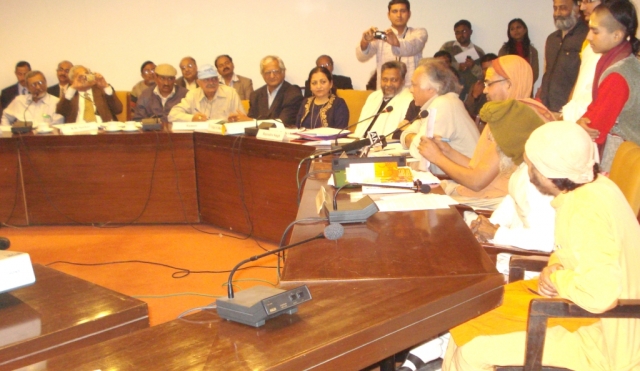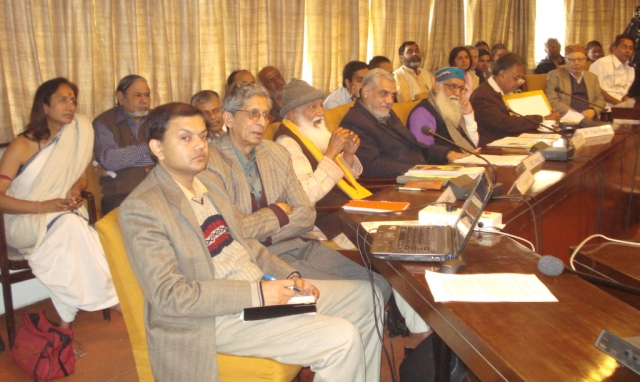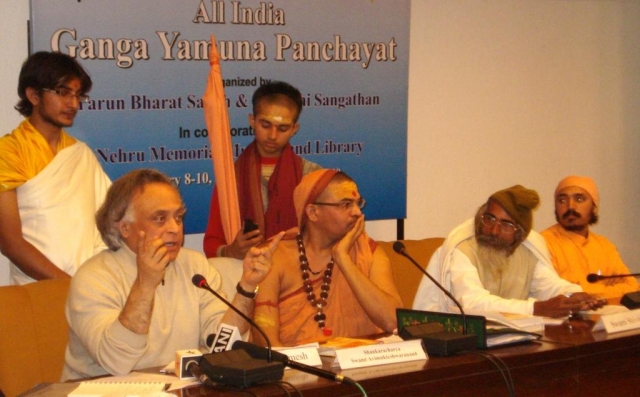Charter of All India Ganga Yamuna Panchayat submitted to Minister of Environment8-10 February 2010
In its concluding session on 10th February, the all India Ganga Yamuna Panchayat organized by Tarun Bharat Sangh and Manushi Sangathan presented a Charter of Demands to Minister of Environment, Mr Jairam Ramesh for the effective implementation of the New Ganga and Yamuna Action Plans. The Panchayat was inaugurated on February 8th by Shri Digvijay Singh, General Secretary, All India Congress Committee at Nehru Memorial Museum and Library which hosted the Panchayat.
Swami Avimukteshwaranand Saraswati of Jyotirmath presided over its proceedings on all three days as representative of the Shankracharya Swaroopanand ji..
The Panchayat began by felicitating Swami Shivananda of Matri Sadan in Haridwar who along with young sanyasis of his ashram succeeded in pressuring the Uttarakhand government to restore the Kumbh area to its 1998 status in order to stop the illegal mining on Ganga river bed in the Kumbh Kshetra of Haridwar through a 107 day Satyagraha. The young sanyasis of Matri Sadan did not give up their fast even when arrested and put behind bars on trumped up criminal charges.
While expressing its appreciation of the intervention made by Minister of Environment in reminding the Uttarakhand Government that the ongoing mining in the Ganga riverbed was against environmental laws, the Panchayat expressed deep concern over the fact that the mining in the riverbed at Haridwar has not yet stopped. That is why one of the young sanyasis of Matri Sadan, brahmachari Dayanand is still continuing his satyagraha despite being admitted in hospital. The Panchayat urged the Minister of Environment to take effective steps to ensure that the Uttarakhand government stops this illegal mining forthwith.
The Panchayat also expressed solidarity with Baba Nagnath-- (Samshan Peethadheeshwar), Manikarnika Ghat, Varanasi—whose fast unto death has today entered 572nd day to protest against the denial of fresh waters of mother Ganga to the ancient holy city of Varanasi on account of Tehri and other dams as well as numerous other obstructions that stop the aviral flow of Ganga.
The Panchayat witnessed participation of river experts, environmental engineers, members of Ganga Yamuna Jalbiradri from different parts of India as well as members of the Prime Minister’s National Ganga Basin Authority and U.P. Ganga Basin Authority.
During the deliberations on the final day, the Environment Minister Mr Jairam Ramesh expressed his helplessness in decommissioning the Loharinag Pala dam since Rs 1,000 crore had already been spent on this project. Therefore, the Government would find it hard to scrap the project. However, he said he was personally convinced that the project would have undesirable consequences. In response, the entire Panchayat endorsed the offer made by Swami Avimukteshwaranand Saraswati representative of H.H. Jagadguru Shankaracharya of Jyotishpeeth and Dwarka Shardapeeth that he would lead a fund raising campaign of the all India Ganga Jalbiradari to recompense the Government to the full extent of Rs 1,000 crore that had been spent on the Loharinag Pala project, if the Government agreed to dismantle the destructive dam. He requested the Minister to convey this decision to the Prime Minister, Finance Minsiter, Mr Pranab Mukherjee, Power Minister, Mr Shinde and other concerned ministers and authorities. Swami Avimukteshwaranand said that he was prepared to sign a Memoradum of Understanding with the Government of India on this issue.
The following resolutions were passed unanimously to be presented to the Environment Minister as a Charter of Ganga-Yamuna Panchayat:
- Rivers anywhere in the world are the lifeline of any society. However, Ganga and Yamuna are unique, having religious and spiritual significance in the hearts and minds of the Indian people. Unfortunately these rivers are dying which is a matter of serious concern not only for the survival of our physical being but the very basis on which our culture, spirituality, dharma and civilization, rests. These dying rivers can be revived and restored as bounties of nature, only when the task is taken up as a sacred mission jointly by sarkar, samaj and sants (the Government, the people and spiritual leaders), in all sincerity as a duty- as dharma- to be accomplished within a targeted time frame.
- The Panchayat considers it a sacred duty to protect and preserve the pristine purity of Ganga and Yamuna. By focusing on Ganga and Yamuna we do not at all intend to undermine the religious, spiritual, social, cultural importance and significance of numerous other rivers of India. However we feel the process of rejuvenating these two rivers will inevitably catalyze a similar process for all other rivers as well.
- Ganga and Yamuna are popularly referred to as nurturing mothers; they cannot be treated as mere “resources” to be exploited. The Government should amend the notification of Ganga Yamuna Action Plans to give due respect to the dharmic and spiritual significance of these two rivers have in the hearts and minds of the people of India.
- The three streams—Bhagirathi, Alakhnanda and Mandakini—must be treated as integral parts of Ganga.
- The Panchayat is of the firm belief that the protection, revival and rejuvenation of Ganga and Yamuna with all its eco-systems, will not only help in solving the problem of drinking water but will recharge the earth and make water available for rational use in agriculture, thus supporting nation in its endeavor to attain food sovereignty.
1)The Government must:
- Institute effective and empowered institutional mechanisms for people’s participation in giving direction, implementation as well as monitoring of Ganga Yamuna Action Plans, especially of those living in and around these two rivers.
- Provide all information regarding these Action Plans in the public domain;Institutionalize effective measures for transparency and accountability right at the outset of these Plans. No money should be spent on these plans till such measures are put in place.
- Change the nomenclature of the head of the Ganga Basin Authority to “Mukhya Sewak” and all other members as “Sewaks” to remind them that they are trustees on behalf of the people of this unique national and natural heritage.
- Ensure that all the small rivers that merge into Ganga and Yamuna are given protection under the new Action Plans.
- Declare a moratorium followed by a total ban on construction of further dams, barrages, artificial embankments, tunnels, express highways and all other activities that enslave or interfere with the flow of Ganga, Yamuna and their tributaries from the point of their origin in Gomukh and Yamunotri to Ganga Sagar.
- Scrap the dams under construction or in the pipe-line and decommission the already constructed dams in a phased manner within a set time frame as integral parts of Ganga Yamuna Action Plans.
- Institute a total ban on dumping domestic sewage, solid waste and industrial waste into Ganga and Yamuna: It is not enough that waste and polluted water be treated with chemicals and poured into our sacred rivers. They need to be directed elsewhere for industrial, agricultural and domestic use. Polluted water -treated or untreated –should under no circumstances be dumped into the the rivers Ganga and Yamuna.
- Declare immediate moratorium followed by a total ban on land use change of flood plains.
- Declare a permanent and total ban on construction, mining and all such activities detrimental to the health of the river in the catchment areas of the river in the mountains and in the flood plains. Only those activities such as planting trees which enhance the value of floodplains should be permitted.
- Enact appropriate laws for the protection, preservation and sanctity of river Ganga and its main tributary Yamuna, since Ganga has been officially declared as a “National River”. Violation of this law must be treated as a criminal offence in addition to inviting punitive damages.
2)The new Ganga and Yamuna Action Plans must:
- Be aimed at ensuring that the waters of Ganga and Yamuna flow aviral: Gamnam, gamnam iti Ganga.” This is a pre condition for Ganga and Yamuna waters to retain the same quality of purity as found at Gangotri and Yamunotri.
- Promote organic farming in the Ganga Yamuna belt and prevent the use of harmful chemical fertilizers and industrial chemicals which are currently seeping into the ground water and into Ganga Yamuna.
- Undertake clear demarcation of flood plains all along the course of these rivers on maps as well as on the ground and make this information available in the public domain. This is urgently needed to make citizens aware of the endangered floodplains which need urgent protection and rejuvenation.
- Undertake emergency measures for catchment area protection and treatment, protection of existing forests, regeneration and reforestation of Himalayan forests as well as river banks all along the course of Ganga and Yamuna with native varieties and panchvati.
- Implement on an emergency footing soil and water conservation measures and integrated watershed management of the Ganga basin.
- Ensure rejuvenation of dying ponds, water channels, streams, rivulets, and all the tributaries of Ganga and Yamuna.
- Assist cities and towns in conserving rain water and reviving their dying water bodies which will recharge their ground water sources for their daily needs instead of forcing them to draw them from distant rivers at great expense and ecological cost. This will eliminate the need for destroying the ecologically imperative aviral flow of the fresh waters of Ganga and Yamuna.
- Ensure the protection, rejuvenation and revival of the ecological health, flora and fauna and micro organisms of Ganga and Yamuna. These are the most reliable indicators of the health of the river.
- Undertake active promotion of irrigation methods that involve scientific and rational use of water in agriculture.
- Bring about effective control on the use of harmful pesticides and insecticides in agriculture which are poisoning both groundwater resources as well as these rivers.
Rajendra Singh (Tarun Bharat Sangh) Madhu Kishwar (Manushi Sangathan)
/articles/ganga-yamuna-panchayat-held-february-2010-nehru-memorial-museum


